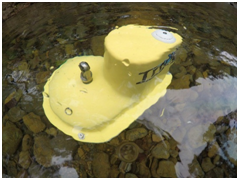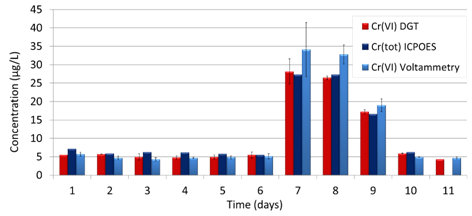New Caledonia’s ores are not only rich in Nickel but also contain a wealth of other elements including chromium. While chromium is not currently exploited, historical exploitation combined present day mining for nickel ores causes the release of chromium into creeks and rivers. Under oxic conditions the toxic hexavalent formexists and potentially presents a public health problemif not monitored correctly.
Over the last few years DGT Research has developed a new DGT device containing a binding layer specifically designed to retain hexavalent chromium.
Using this new DGT in our THOË sampler provides a perfect solution at remote monitoring sites.
 New Caledonia’s ores are not only rich in Nickel but also contain a wealth of other elements including chromium. While chromium is not currently exploited, historical exploitation combined present day mining for nickel ores causes the release of chromium into creeks and rivers. Under oxic conditions the toxic hexavalent form exists and potentially presents a public health problem if not monitored correctly.
New Caledonia’s ores are not only rich in Nickel but also contain a wealth of other elements including chromium. While chromium is not currently exploited, historical exploitation combined present day mining for nickel ores causes the release of chromium into creeks and rivers. Under oxic conditions the toxic hexavalent form exists and potentially presents a public health problem if not monitored correctly.
Over the last few years DGT Research has developed a new DGT device containing a binding layer specifically designed to retain hexavalent chromium. Combing this new DGT with our THOË sampler provides a perfect solution at remote monitoring sites.
When determining hexavalent chromium in natural waters, the time between sampling and analysis is a critical factor in ensuring accurate determination of hexavalent chromium concentrations. Using our THOË water sampler with DGT devices, design to retain hexavalent Chromium, we demonstrated that THOË is a simple and reliable alternative to grab sampling. Samples are filtered and stabilized using the DGT technology and exposed and isolated at preprogrammed intervals using the THOË sampler.
An eleven-day study was conducted to compare hexavalent chromium concentrations obtained using DGT devices installed in the THOË sampler with classical analytical analysis performed on grab samples.
Results between the different sampling and analytical techniques were very similar, with the THOË sampler perfectly preserving the hexavalent chromium concentrations over the deployment period.

Monitoring hexavalent
chromium in a local river
using a THOË sampler



